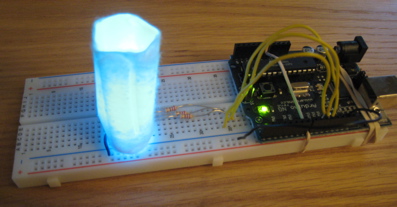For a diffuser, I used a cotton swab taped along the long edge into a cylinder. I modified the Arduino code so that each time, 'r', 'g', and 'b' are pressed, brightness in the corresponding LED increases by 10%. I also modified the code so that, each time an input is read, the LED levels reset and start over.
For example, input 'rrrggb' will set the red LED to 30%, green to 20%, and blue to 10%. The next time an input is read (for example, 'ggrr'), the LED brightnesses will be reset to 0 and then set to the new input level (in this example, green at 20%, red at 20%, and blue at 0%).
If a user types in more than 100% of any LED color (for example, types 'g' 11 times or 20 times), the LED of that corresponding color will default to the maximum (100%).
Components Used
Arduino Microprocsessor
Breadboard
3 220 Ohm Resistors
Red, green, blue LEDs
Cotton Swab taped into cylinder for diffuser
Arduino Code
/*
* Serial RGB LED
* ---------------
* Serial commands control the brightness of R,G,B LEDs
* Command structure is "<colorCode>*", where "colorCode" is
* one of "r","g", or "b".
* E.g. "r" sets the red LED brightness to 10%
* "rrr" sets the red LED brightness to 30%
* "ggb" sets the green LED brightness to 20& and the blue by 10%
*
* Each time an input is read, the LEDs reset
*
* Created 18 October 2006
* copyleft 2006 Tod E. Kurt <tod@todbot.com
* http://todbot.com/
*
* Adapted 5 September 2007
* copylefter 2007 Ryan Aipperspach <ryanaip@alumni.rice.edu>
*
* Adapted 13 September 2007
* copylefter 2007 Jonathan Breitbart <breity@berkeley.edu>
*
*/
//include support for manipulating strings.
//for a useful string comparison function, see the bottom of this file... stringsEqual()
#include <stdio.h>
#include <string.h>
char serInString[100]; // array that will hold the different bytes of the string. 100=100characters;
// -> you must state how long the array will be else it won't work properly
char colorCode;
int colorVal;
int redPin = 9; // Red LED, connected to digital pin 9
int greenPin = 10; // Green LED, connected to digital pin 10
int bluePin = 11; // Blue LED, connected to digital pin 11
int redValue = 127;
int greenValue = 127;
int blueValue = 127;
float redValueFloat = 0;
float greenValueFloat = 0;
float blueValueFloat = 0;
void setup() {
pinMode(redPin, OUTPUT); // sets the pins as output
pinMode(greenPin, OUTPUT);
pinMode(bluePin, OUTPUT);
Serial.begin(9600);
analogWrite(redPin, redValue); // set them all to mid brightness
analogWrite(greenPin, greenValue); // set them all to mid brightness
analogWrite(bluePin, blueValue); // set them all to mid brightness
Serial.println("enter color command (e.g. 'rrrrrrrrbbbb') :");
}
void loop () {
//read the serial port and create a string out of what you read
readSerialString(serInString, 100);
//reset each float value
//so that each LED resets to 0 each time there is an input
blueValueFloat = 0;
redValueFloat = 0;
greenValueFloat = 0;
//read commands of the form 'rrrb'
processRepeatKeyCommands(serInString, 100);
//Erase anything left in the serial string, preparing it for the
//next loop
resetSerialString(serInString, 100);
delay(100); // wait a bit, for serial data
}
void resetSerialString (char *strArray, int length) {
for (int i = 0; i < length; i++) {
strArray[i] = '\0';
}
}
//read a string from the serial and store it in an array
//you must supply the array variable
void readSerialString (char *strArray, int maxLength) {
int i = 0;
if(!Serial.available()) {
return;
}
while (Serial.available() && i < maxLength) {
strArray[i] = Serial.read();
i++;
}
}
//go through the string, and increase the red value for each 'r',
//the green value for each 'g', and the blue value for each 'b'.
//For example "rrrg" sets red at 30% and green at 10%.
void processRepeatKeyCommands(char *strArray, int maxLength) {
int i = 0;
//loop through the string (strArray)
//i = the current position in the string
//Stop when either (a) i reaches the end of the string or
// (b) there is an empty character '\0' in the string
while (i < maxLength && strArray[i] != '\0') {
//Read in the character at position i in the string
colorCode = serInString[i];
//If the character is r (red)...
if (colorCode == 'r') {
//Increase the current red value by 10%
redValueFloat = redValueFloat + 25.5;
//if user input more than 10 'r's, set red value to maximum
if (redValueFloat > 255) {
redValueFloat = 255;
}
redValue = (int)redValueFloat;
analogWrite(redPin, redValue);
Serial.print("setting color r to ");
Serial.println(redValue);
//If the character is g (green)...
} else if (colorCode == 'g') {
//Increase the current green value by 10%
greenValueFloat = greenValueFloat + 25.5;
//if user input more than 10 'g's, set green value to maximum
if (greenValueFloat > 255) {
greenValueFloat = 255;
}
greenValue = (int)greenValueFloat;
analogWrite(greenPin, greenValue);
Serial.print("setting color g to ");
Serial.println(greenValue);
//If the character is b (blue)...
//Increase the current blue value by 10%
} else if (colorCode == 'b') {
blueValueFloat = blueValueFloat + 25.5;
//if user input more than 10 'b's, set blue value to maximum
if (blueValueFloat > 255) {
blueValueFloat = 255;
}
blueValue = (int)blueValueFloat;
analogWrite(bluePin, blueValue);
Serial.print("setting color b to ");
Serial.println(blueValue);
}
//in case any of the colors have not been used in the input
//set those values to default (0)
blueValue = (int)blueValueFloat;
greenValue = (int)greenValueFloat;
redValue = (int)redValueFloat;
analogWrite(bluePin, blueValue);
analogWrite(greenPin, greenValue);
analogWrite(redPin, redValue);
//Move on to the next character in the string
//From here, the code continues executing from the "while" line above...
i++;
}
}
//compare two strings to see if they are equal
//compares the first 'numCharacters' characters of string1 and string2 to
//see if they are the same
//
//E.g. stringsEqual("hello","hello",5) => true
// stringsEqual("hello","helaabbnn",3) => true
// stringsEqual("hello","helaa",5) => false
boolean stringsEqual(char *string1, char *string2, int numCharacters) {
if (strncmp(string1, string2, numCharacters) == 0) {
return true;
} else {
return false;
}
}




